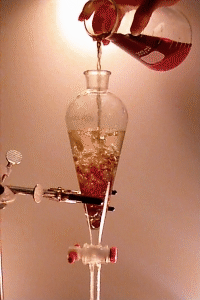
CHM3120L
Introduction to Analytical Chemistry: Laboratory
| Lab Schedule |
| LON-CAPA Pre-Labs |
| Resources |
| Contact Instructor |
| Chemistry Home Page |
![]()
Copper in Metal Alloys by Liquid-Liquid Extraction: Introduction
Neocuproine (2,9-dimethyl-1,10-phenanthroline), under the right conditions, is almost a specific extraction reagent for Cu(I). The complex that forms is soluble in chloroform and absorbs strongly at 457 nm. This method may be used to determine copper in various alloys such as cast iron, solder, and steel.
In this experiment, the alloy sample is dissolved and Cu(II) then reduced to Cu(I) with hydroxylamine hydrochloride (NH2OH·HCl). Sodium citrate is used as a masking agent to prevent interference by other metals. When the Cu-neocuproine complex is formed it can be extracted into a small volume of chloroform, where the color will develop. The absorbance of the chloroform solution is read to determine the concentration of Cu in the original sample.